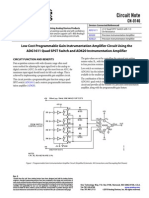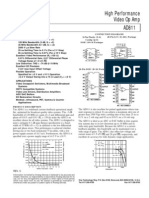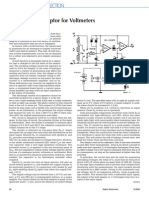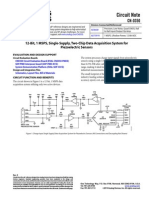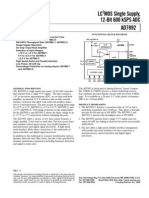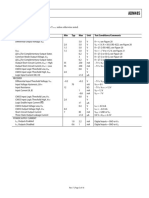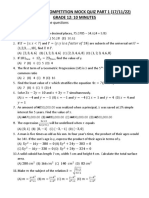ADXL202/ADXL210: Using The Analog Output Power Cycling When Using The Digital Output
ADXL202/ADXL210: Using The Analog Output Power Cycling When Using The Digital Output
Uploaded by
mhasansharifiCopyright:
Available Formats
ADXL202/ADXL210: Using The Analog Output Power Cycling When Using The Digital Output
ADXL202/ADXL210: Using The Analog Output Power Cycling When Using The Digital Output
Uploaded by
mhasansharifiOriginal Title
Copyright
Available Formats
Share this document
Did you find this document useful?
Is this content inappropriate?
Copyright:
Available Formats
ADXL202/ADXL210: Using The Analog Output Power Cycling When Using The Digital Output
ADXL202/ADXL210: Using The Analog Output Power Cycling When Using The Digital Output
Uploaded by
mhasansharifiCopyright:
Available Formats
ADXL202/ADXL210
USING THE ANALOG OUTPUT Power Cycling When Using the Digital Output
The ADXL202/ADXL210 was specifically designed for use with An alternative is to run the microcontroller at a higher clock
its digital outputs, but has provisions to provide analog outputs rate and put it into shutdown between readings, allowing the
as well. use of the digital output. In this approach the ADXL202/
Duty Cycle Filtering ADXL210 should be set at its fastest sample rate (T2 = 0.5 ms),
An analog output can be reconstructed by filtering the duty with a 500 Hz filter at XFILT and YFILT. The concept is to ac-
cycle output. This technique requires only passive components. quire a reading as quickly as possible and then shut down the
The duty cycle period (T2) should be set to 1 ms. An RC filter ADXL202/ADXL210 and the microcontroller until the next
with a 3 dB point at least a factor of 10 less than the duty cycle sample is needed.
frequency is connected to the duty cycle output. The filter resis- In either of the above approaches, the ADXL202/ADXL210
tor should be no less than 100 kΩ to prevent loading of the can be turned on and off directly using a digital port pin on the
output stage. The analog output signal will be ratiometric to the microcontroller to power the accelerometer without additional
supply voltage. The advantage of this method is an output scale components. The port should be used to switch the common
factor of approximately double the analog output. Its disadvan- pin of the accelerometer so the port pin is “pulling down.”
tage is that the frequency response will be lower than when
using the XFILT, YFILT output. CALIBRATING THE ADXL202/ADXL210
XFILT, YFILT Output The initial value of the offset and scale factor for the ADXL202/
The second method is to use the analog output present at the ADXL210 will require calibration for applications such as tilt
XFILT and YFILT pin. Unfortunately, these pins have a 32 kΩ measurement. The ADXL202/ADXL210 architecture has been
output impedance and are not designed to drive a load directly. designed so that these calibrations take place in the software of
An op amp follower may be required to buffer this pin. The the microcontroller used to decode the duty cycle signal. Cali-
advantage of this method is that the full 5 kHz bandwidth of the bration factors can be stored in EEPROM or determined at
accelerometer is available to the user. A capacitor still must be turn-on and saved in dynamic memory.
added at this point for filtering. The duty cycle converter should For low g applications, the force of gravity is the most stable,
be kept running by using RSET <10 MΩ. Note that the acceler- accurate and convenient acceleration reference available. A
ometer offset and sensitivity are ratiometric to the supply volt- reading of the 0 g point can be determined by orientating the
age. The offset and sensitivity are nominally: device parallel to the earth’s surface and then reading the output.
0 g Offset = VDD/2 2.5 V at +5 V A more accurate calibration method is to make a measurements
ADXL202 Sensitivity = (60 mV × VS)/g 300 mV/g at +5 V, VDD at +1 g and –1 g. The sensitivity can be determined by the two
ADXL210 Sensitivity = (20 mV × VS)/g 100 mV/g at +5 V, VDD measurements.
To calibrate, the accelerometer’s measurement axis is pointed
USING THE ADXL202/ADXL210 IN VERY LOW POWER directly at the earth. The 1 g reading is saved and the sensor is
APPLICATIONS turned 180° to measure –1 g. Using the two readings, the sensi-
An application note outlining low power strategies for the tivity is:
ADXL202/ADXL210 is available. Some key points are pre-
sented here. It is possible to reduce the ADXL202/ADXL210’s Let A = Accelerometer output with axis oriented to +1 g
average current from 0.6 mA to less than 20 µA by using the Let B = Accelerometer output with axis oriented to –1 g then:
following techniques: Sensitivity = [A – B]/2 g
1. Power Cycle the accelerometer. For example, if the +1 g reading (A) is 55% duty cycle and the
–1 g reading (B) is 32% duty cycle, then:
2. Run the accelerometer at a Lower Voltage, (Down to 3 V).
Sensitivity = [55% – 32%]/2 g = 11.5%/g
Power Cycling with an External A/D
Depending on the value of the XFILT capacitor, the ADXL202/ These equations apply whether the output is analog, or duty
ADXL210 is capable of turning on and giving a good reading in cycle.
1.6 ms. Most microcontroller based A/Ds can acquire a reading Application notes outlining algorithms for calculating accelera-
in another 25 µs. Thus it is possible to turn on the ADXL202/ tion from duty cycle and automated calibration routines are
ADXL210 and take a reading in <2 ms. If we assume that a available from the factory.
20 Hz sample rate is sufficient, the total current required to
take 20 samples is 2 ms × 20 samples/s × 0.6 mA = 24 µA aver-
age current. Running the part at 3 V will reduce the supply
current from 0.6 mA to 0.4 mA, bringing the average current
down to 16 µA.
The A/D should read the analog output of the ADXL202/
ADXL210 at the XFILT and Y FILT pins. A buffer amplifier is
recommended, and may be required in any case to amplify the
analog output to give enough resolution with an 8-bit to 10-bit
converter.
–10– REV. B
You might also like
- Obsolete: Low Cost Accelerometers With Digital Output ADXL202/ADXL210Document11 pagesObsolete: Low Cost Accelerometers With Digital Output ADXL202/ADXL210adfumegaNo ratings yet
- 12-V Voltage Sensing Circuit With An Isolated AmplifierDocument8 pages12-V Voltage Sensing Circuit With An Isolated AmplifierSirJones KekapohNo ratings yet
- ACT30BHTDocument9 pagesACT30BHTRICHIHOTS2No ratings yet
- Low Cost Accelerometers With Digital Output ADXL202/ADXL210: G/ HZ Allowing Signals Below 5 MG To Be ResolvedDocument1 pageLow Cost Accelerometers With Digital Output ADXL202/ADXL210: G/ HZ Allowing Signals Below 5 MG To Be ResolvedmhasansharifiNo ratings yet
- ADXL202/ADXL210: F C (X, Y) F CDocument1 pageADXL202/ADXL210: F C (X, Y) F CmhasansharifiNo ratings yet
- Low Cost Accelerometers With Digital Output ADXL202/ADXL210: G/ HZ Allowing Signals Below 5 MG To Be ResolvedDocument11 pagesLow Cost Accelerometers With Digital Output ADXL202/ADXL210: G/ HZ Allowing Signals Below 5 MG To Be ResolvedmhasansharifiNo ratings yet
- Isolation Circuits For General Purpose Analog Applications: ContentsDocument10 pagesIsolation Circuits For General Purpose Analog Applications: ContentsNarendra BholeNo ratings yet
- AN0021Document19 pagesAN0021periodoNo ratings yet
- Low Cost 1.2 G Dual Axis Accelerometer ADXL213: Features General DescriptionDocument12 pagesLow Cost 1.2 G Dual Axis Accelerometer ADXL213: Features General DescriptionMarlon PerinNo ratings yet
- 01-MSP430F42x Single Chip Weigh Scale (Slaa220) PDFDocument7 pages01-MSP430F42x Single Chip Weigh Scale (Slaa220) PDFKfagNo ratings yet
- High Accuracy Impedance Measurements Using 12-Bit Impedance ConvertersDocument6 pagesHigh Accuracy Impedance Measurements Using 12-Bit Impedance Converterschristobal_huntaNo ratings yet
- Signal ProcessingDocument47 pagesSignal ProcessingAthira rcNo ratings yet
- CN0146Document3 pagesCN0146soft4gsmNo ratings yet
- Ad 811Document16 pagesAd 811srboghe651665No ratings yet
- Spacelas Co., LTD: Preliminary!JAN.30,2010Document4 pagesSpacelas Co., LTD: Preliminary!JAN.30,2010James WinsorNo ratings yet
- ACT30Document10 pagesACT30arao_filhoNo ratings yet
- HOLD Adapter Za VoltmetarDocument1 pageHOLD Adapter Za VoltmetarDražen BorčićNo ratings yet
- CN0350Document7 pagesCN0350Narayan ApteNo ratings yet
- Smps For CRT Monitors With The L6565: AN1657 Application NoteDocument9 pagesSmps For CRT Monitors With The L6565: AN1657 Application Noterdc02271No ratings yet
- Iso122sensor de TensionDocument15 pagesIso122sensor de TensionRichard ZerpaNo ratings yet
- Es 51922Document35 pagesEs 51922ReVNo ratings yet
- ADXL345BCCZ AccelerometerDocument19 pagesADXL345BCCZ Accelerometerselim007No ratings yet
- AD215Document12 pagesAD215gmludNo ratings yet
- Unipolar To Bipolar Analog Voltage ConversionDocument20 pagesUnipolar To Bipolar Analog Voltage ConversionGautam MonipatroNo ratings yet
- GSM Based Controling of Agriculture MotorDocument69 pagesGSM Based Controling of Agriculture MotorSaieesh somaNo ratings yet
- AD8002 Data SheetDocument21 pagesAD8002 Data SheetMartinCharlyNo ratings yet
- Noninverting Circuit For High-To-Low Voltage Level Translation Very ImportantDocument7 pagesNoninverting Circuit For High-To-Low Voltage Level Translation Very Importantsung quekNo ratings yet
- Integrated Circuit True RMS-to-DC Converter: C To +125 C Operation (AD536AS)Document8 pagesIntegrated Circuit True RMS-to-DC Converter: C To +125 C Operation (AD536AS)Decker JamesNo ratings yet
- Circuit Function and Benefits: AD9834 AD5620Document3 pagesCircuit Function and Benefits: AD9834 AD5620Anonymous oyUAtpKNo ratings yet
- Multiplying Dacs: Flexible Building BlocksDocument8 pagesMultiplying Dacs: Flexible Building BlocksLucas McCauleyNo ratings yet
- Compteur 7757 - A PDFDocument16 pagesCompteur 7757 - A PDFbromartNo ratings yet
- DiDocument6 pagesDipani256No ratings yet
- Taos TCS3472 DatasheetDocument26 pagesTaos TCS3472 DatasheetKathryn WorkmanNo ratings yet
- An 477Document28 pagesAn 477radaresNo ratings yet
- 11 DataAcquisAndManipulationDocument30 pages11 DataAcquisAndManipulationmokahhsalkoshbsNo ratings yet
- Implementationofan 8 Bit Successive Subtraction ADCDocument7 pagesImplementationofan 8 Bit Successive Subtraction ADCVhann_FraidNo ratings yet
- De Accm2g2Document4 pagesDe Accm2g2foxHellNo ratings yet
- An-742 Application Note: Frequency Domain Response of Switched-Capacitor AdcsDocument8 pagesAn-742 Application Note: Frequency Domain Response of Switched-Capacitor AdcskabuslagakNo ratings yet
- Case StudyDocument32 pagesCase StudyEri PranantoNo ratings yet
- AN132f Fidelity Testing For AD ConvertersDocument8 pagesAN132f Fidelity Testing For AD ConvertersDan HauerNo ratings yet
- LC MOS Single Supply, 12-Bit 600 KSPS ADC: S Conversion TimeDocument14 pagesLC MOS Single Supply, 12-Bit 600 KSPS ADC: S Conversion TimeThang PhamNo ratings yet
- ADXL210Document11 pagesADXL210JaehyupKimNo ratings yet
- Ssm2120 2 ExpanderDocument12 pagesSsm2120 2 ExpandershirtquittersNo ratings yet
- XR-2206 Function GeneratorDocument15 pagesXR-2206 Function GeneratorWagner MirandaNo ratings yet
- Ad 698Document12 pagesAd 698Roozbeh BahmanyarNo ratings yet
- ADCMT TR8652 ElectrometerDocument4 pagesADCMT TR8652 Electrometerbudi0251No ratings yet
- DiDocument5 pagesDiTao Quang BinhNo ratings yet
- Low-Cost With Duty Cycle Output: 2 G Dual-Axis AccelerometerDocument12 pagesLow-Cost With Duty Cycle Output: 2 G Dual-Axis AccelerometerpraveensahNo ratings yet
- Control Volumen DigitalDocument9 pagesControl Volumen DigitalDaniel Carvajal CortesNo ratings yet
- LC MOS 8-Channel, 12-Bit High Speed Data Acquisition System: S Conversion TimeDocument20 pagesLC MOS 8-Channel, 12-Bit High Speed Data Acquisition System: S Conversion Timeharsh.nsit2007752No ratings yet
- Minitrol Series: Installation & Operating InstructionsDocument26 pagesMinitrol Series: Installation & Operating InstructionsFahrur RadziNo ratings yet
- Analog To Digital Converter and Vise VersDocument7 pagesAnalog To Digital Converter and Vise VersSpyx MeniNo ratings yet
- Lect 6Document24 pagesLect 6OmisaNo ratings yet
- Complete 8-Bit A-to-D Converter AD570 : Ms 8C To +708C: AD570J 8C To +1258C: AD570SDocument8 pagesComplete 8-Bit A-to-D Converter AD570 : Ms 8C To +708C: AD570J 8C To +1258C: AD570SFida PyrtuhNo ratings yet
- Electronic Circuits - II Lab ManualDocument26 pagesElectronic Circuits - II Lab Manualbalabasker100% (1)
- Reference Guide To Useful Electronic Circuits And Circuit Design Techniques - Part 1From EverandReference Guide To Useful Electronic Circuits And Circuit Design Techniques - Part 1Rating: 2.5 out of 5 stars2.5/5 (3)
- Reference Guide To Useful Electronic Circuits And Circuit Design Techniques - Part 2From EverandReference Guide To Useful Electronic Circuits And Circuit Design Techniques - Part 2No ratings yet
- Projecting Hints: Function Modules FS20D-SR-WSDocument1 pageProjecting Hints: Function Modules FS20D-SR-WSmhasansharifiNo ratings yet
- Adm485 13Document1 pageAdm485 13mhasansharifiNo ratings yet
- ADM485 Test Circuits: Figure 20. Driver Voltage Measurement Figure 23. Driver Enable/DisableDocument1 pageADM485 Test Circuits: Figure 20. Driver Voltage Measurement Figure 23. Driver Enable/DisablemhasansharifiNo ratings yet
- ADM485 Switching CharacteristicsDocument1 pageADM485 Switching CharacteristicsmhasansharifiNo ratings yet
- Projecting Hints: GeneralDocument1 pageProjecting Hints: GeneralmhasansharifiNo ratings yet
- Inlet Modules Model Code: ExampleDocument1 pageInlet Modules Model Code: ExamplemhasansharifiNo ratings yet
- Timing Specifications: Table 2Document1 pageTiming Specifications: Table 2mhasansharifiNo ratings yet
- Adm485 16 PDFDocument1 pageAdm485 16 PDFmhasansharifiNo ratings yet
- Main Load Modules Model Code: ExampleDocument1 pageMain Load Modules Model Code: ExamplemhasansharifiNo ratings yet
- Adm485 8Document1 pageAdm485 8mhasansharifiNo ratings yet
- ADXL202/ADXL210: Peak-to-Peak Noise Estimate 95% Bandwidth C, C Rms Noise Probability (RmsDocument1 pageADXL202/ADXL210: Peak-to-Peak Noise Estimate 95% Bandwidth C, C Rms Noise Probability (RmsmhasansharifiNo ratings yet
- Figure 15. Unloaded Driver Differential Outputs Figure 18. Driver/Receiver Propagation Delays, High To LowDocument1 pageFigure 15. Unloaded Driver Differential Outputs Figure 18. Driver/Receiver Propagation Delays, High To LowmhasansharifiNo ratings yet
- ADM485 Typical Performance Characteristics: Rev. F - Page 7 of 16Document1 pageADM485 Typical Performance Characteristics: Rev. F - Page 7 of 16mhasansharifiNo ratings yet
- ADXL202/ADXL210: Absolute Maximum Ratings Pin ConfigurationDocument1 pageADXL202/ADXL210: Absolute Maximum Ratings Pin ConfigurationmhasansharifiNo ratings yet
- Adxl202 5 PDFDocument1 pageAdxl202 5 PDFmhasansharifiNo ratings yet
- ADM485 Absolute Maximum Ratings: Table 4. TransmittingDocument1 pageADM485 Absolute Maximum Ratings: Table 4. TransmittingmhasansharifiNo ratings yet
- ADM485 Pin Configuration and Function DescriptionsDocument1 pageADM485 Pin Configuration and Function DescriptionsmhasansharifiNo ratings yet
- 5 V Low Power EIA RS-485 Transceiver ADM485: Features Functional Block DiagramDocument1 page5 V Low Power EIA RS-485 Transceiver ADM485: Features Functional Block DiagrammhasansharifiNo ratings yet
- Revision History: 04/08-Rev. E To Rev. F 1/03-Rev. B To Rev. CDocument1 pageRevision History: 04/08-Rev. E To Rev. F 1/03-Rev. B To Rev. CmhasansharifiNo ratings yet
- Adxl202 5 PDFDocument1 pageAdxl202 5 PDFmhasansharifiNo ratings yet
- Adxl202 9Document1 pageAdxl202 9mhasansharifiNo ratings yet
- Adm485 Specifications: V 5 V 5%, All Specifications T Tot, Unless Otherwise NotedDocument1 pageAdm485 Specifications: V 5 V 5%, All Specifications T Tot, Unless Otherwise NotedmhasansharifiNo ratings yet
- Adxl202 4 PDFDocument1 pageAdxl202 4 PDFmhasansharifiNo ratings yet
- ADXL202/ADXL210: Outline DimensionsDocument1 pageADXL202/ADXL210: Outline DimensionsmhasansharifiNo ratings yet
- Adxl202/Adxl210-Specifications: ADXL202/JQC/AQC ADXL210/JQC/AQC Parameter Conditions Min Typ Max Min Typ Max UnitsDocument1 pageAdxl202/Adxl210-Specifications: ADXL202/JQC/AQC ADXL210/JQC/AQC Parameter Conditions Min Typ Max Min Typ Max UnitsmhasansharifiNo ratings yet
- AD8009 Part6Document1 pageAD8009 Part6mhasansharifiNo ratings yet
- AD8009 Part1 PDFDocument1 pageAD8009 Part1 PDFmhasansharifiNo ratings yet
- AD8009 Part9 PDFDocument1 pageAD8009 Part9 PDFmhasansharifiNo ratings yet
- DLP FormatDocument12 pagesDLP FormatShiella Mae Olermo CardonaNo ratings yet
- 9 Desconectador AbbDocument24 pages9 Desconectador AbbOscar Gálvez IglesiasNo ratings yet
- Integrated - Math 1.unit 7.unit AssessmentDocument6 pagesIntegrated - Math 1.unit 7.unit AssessmentDan YuNo ratings yet
- Revised Gcse Chem Revised Support 26952Document13 pagesRevised Gcse Chem Revised Support 26952JenNo ratings yet
- Products: TerofireDocument32 pagesProducts: TerofireMohamed Talat FayedNo ratings yet
- Livro Advanced Engineering Thermodynamics - Adrian Bejan - 3rd Ed. - 2006 (Solutions)Document214 pagesLivro Advanced Engineering Thermodynamics - Adrian Bejan - 3rd Ed. - 2006 (Solutions)Rafael SalvagniNo ratings yet
- Sound Wave Cheat CodeDocument10 pagesSound Wave Cheat Codeazamchishty796No ratings yet
- Chapter 2 Free VibrationDocument9 pagesChapter 2 Free VibrationTsiNat NathaNo ratings yet
- G R Reduction AlkaneDocument43 pagesG R Reduction AlkaneManthan HaritashNo ratings yet
- RCDCODEDocument6 pagesRCDCODEGiemhel GeleraNo ratings yet
- Mitutoyo - ABSOLUTE Digimatic CaliperDocument5 pagesMitutoyo - ABSOLUTE Digimatic CaliperHaddy HadiansyahNo ratings yet
- Astm C165Document5 pagesAstm C165Lakruwan100% (1)
- Eshelby Tensors and Overall Properties of Nano-Composites Considering Both Interface Stretching and Bending EffectsDocument34 pagesEshelby Tensors and Overall Properties of Nano-Composites Considering Both Interface Stretching and Bending EffectsM Mohsin RazaNo ratings yet
- Rectangular Microstrip Patch Antenna Design and Simulation For Single S - Band Frequency Using ADSDocument8 pagesRectangular Microstrip Patch Antenna Design and Simulation For Single S - Band Frequency Using ADSMylavarapu SriprithamNo ratings yet
- 6ED10521HB080BA1 Datasheet enDocument2 pages6ED10521HB080BA1 Datasheet enDiego Dandolini PasiniNo ratings yet
- Network AnalysisDocument22 pagesNetwork AnalysisShravan Kumar NamdeoNo ratings yet
- Classification Test IVDocument33 pagesClassification Test IVGalerya MarahuyoNo ratings yet
- 4. คุณกฤษณะ เลขานุกิจDocument32 pages4. คุณกฤษณะ เลขานุกิจJirachai LaohaNo ratings yet
- Elementary ApplicationsDocument3 pagesElementary ApplicationsMECHANICAL ENGINEERINGNo ratings yet
- Bridge Pier Scour: A Review of Processes, Measurements and EstimatesDocument16 pagesBridge Pier Scour: A Review of Processes, Measurements and EstimatesKarthik RNo ratings yet
- G10 Math Q2 Week 1 - Graph of Polynomial FunctionsDocument40 pagesG10 Math Q2 Week 1 - Graph of Polynomial FunctionsOlive BotiloNo ratings yet
- Temperature SensorsDocument10 pagesTemperature Sensorsdevashish.jo11No ratings yet
- Rotary Cam Switches: EC AGE AGE EriesDocument26 pagesRotary Cam Switches: EC AGE AGE EriesResines ValdenNo ratings yet
- Phys 2001Document2 pagesPhys 2001Vikash KumarNo ratings yet
- Midpoint of A Line Segment Worksheet (Editable)Document5 pagesMidpoint of A Line Segment Worksheet (Editable)Seo SoojinNo ratings yet
- Mathematics CompetitionDocument4 pagesMathematics Competitionsegun adebayoNo ratings yet
- 2MKABLODocument2 pages2MKABLOtaharphoneproNo ratings yet
- TE Raychem HVBT Tape - Product DescriptionDocument2 pagesTE Raychem HVBT Tape - Product Descriptionnathan.schmittouNo ratings yet
- Carrs Index Hausner RatioDocument1 pageCarrs Index Hausner Ratiopharmashri5399100% (1)
- DiffusionMRIAnalysis Slicer4.8 SoniaPujolDocument107 pagesDiffusionMRIAnalysis Slicer4.8 SoniaPujolRushi TutorNo ratings yet












